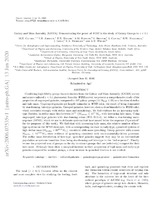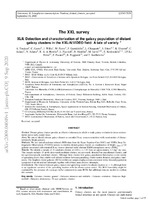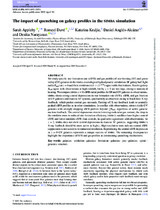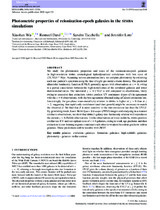Galaxy and Mass Assembly (GAMA): Demonstrating the power of WISE in the study of Galaxy Groups to z < 0.1
Abstract
Combining high-fidelity group characterisation from the Galaxy and Mass Assembly (GAMA) survey
and source-tailored z < 0.1 photometry from the WISE survey, we present a comprehensive study of the
properties of ungrouped galaxies, compared to 497 galaxy groups (4≤ NFoF ≤ 20) as a function of stellar
and halo mass. Ungrouped galaxies are largely unimodal in WISE color, the result of being dominated
by star-forming, late-type galaxies. Grouped galaxies, however, show a clear bimodality in WISE color,
which correlates strongly with stellar mass and morphology. We find evidence for an increasing earlytype fraction, in stellar mass bins between 1010 .Mstellar . 1011 M , with increasing halo mass. Using
ungrouped, late-type galaxies with star-forming colors (W2−W3>3), we define a star-forming mainsequence (SFMS), which we use to delineate systems that have moved below the sequence (“quenched”
for the purposes of this work). We find that with increasing halo mass, the relative number of latetype systems on the SFMS decreases, with a corresponding increase in early-type, quenched systems at
high stellar mass (Mstellar > 1010.5 M ), consistent with mass quenching. Group galaxies with masses
Mstellar < 1010.5 M show evidence of quenching consistent with environmentally-driven processes.
The stellar mass distribution of late-type, quenched galaxies suggests they may be an intermediate
population as systems transition from being star-forming and late-type to the “red sequence”. Finally,
we use the projected area of groups on the sky to extract groups that are (relatively) compact for their
halo mass. Although these show a marginal increase in their proportion of high mass and early-type
galaxies compared to nominal groups, a clear increase in quenched fraction is not evident.
Collections
Related items
Showing items related by title, author, creator and subject.
-
The XXL survey XLII. Detection and characterization of the galaxy population of distant galaxy clusters in the XXL-N/VIDEO field: A tale of variety
Jarvis, M.; Trudeau, A.; Garrel, C. (ESO, 2020)Context. Distant galaxy clusters provide an effective laboratory in which to study galaxy evolution in dense environments and at early cosmic times. Aims. We aim to identify distant galaxy clusters as extended X-ray sources ... -
The impact of quenching on galaxy profiles in the SIMBA simulation
Dave, Romeel; Appleby, Sarah; Kraljic, Katarina (Oxford University Press, 2020)We study specific star formation rate (sSFR) and gas profiles of star-forming (SF) and green valley (GV) galaxies in the SIMBA cosmological hydrodynamic simulation. SF galaxy half-light radii (Rhalf) at z = 0 and their ... -
Photometric properties of reionization-epoch galaxies in the SIMBA simulations
Dave, Romeel; Wu, Xiaohan; Tacchella, Sandro (Oxford University Press, 2020)We study the photometric properties and sizes of the reionization-epoch galaxies in high-resolution SIMBA cosmological hydrodynamical simulations with box sizes of [25,50]h−1Mpc. Assuming various attenuation laws, we ...




